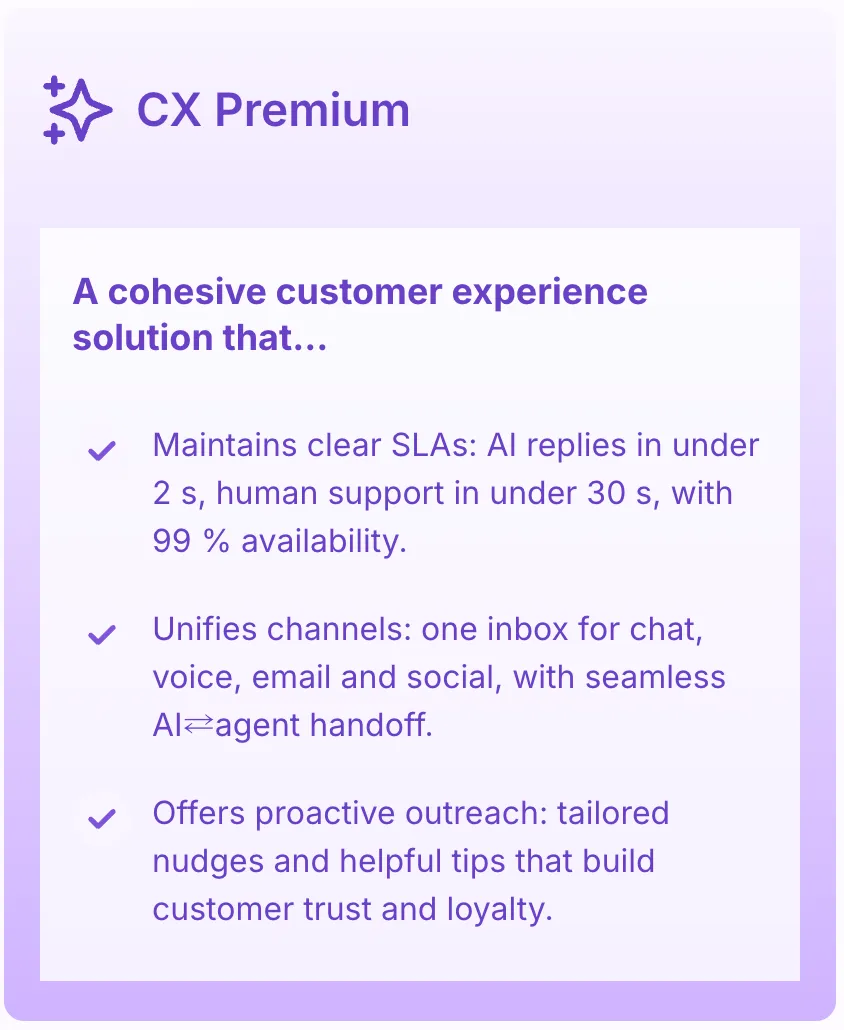It's crucial to understand that customer experience differs from patient experience (PX). Customer experience covers the entire healthcare journey, including administrative processes, digital interactions, and facility environments. Patient experience specifically focuses on the clinical aspects of care delivery and the emotional connection during medical visits.
The impact of CX on healthcare organizations is significant:
- Positive experiences drive patient loyalty and adherence to treatment plans
- Strong CX leads to increased referrals and improved reputation
- Better outcomes result from engaged and satisfied patients
- Enhanced trust between providers and patients
Recent data reveals concerning trends:
- 62% of patients find healthcare systems complicated to navigate
- 95% report negative healthcare experiences
- 66% feel overwhelmed managing their healthcare tasks
These statistics highlight the urgent need for healthcare providers to reimagine their approach to customer experience, focusing on both technological innovation and human-centered care to create meaningful improvements in healthcare delivery.
1. Adopt a Patient-Centric Approach to Healthcare CX
A patient-centric approach transforms standard healthcare delivery into personalized care experiences. This strategy recognizes each patient's unique needs, preferences, and circumstances to create tailored treatment plans that drive better outcomes.
Key Elements of Patient-Centric Care:
- Customized Treatment Plans: Consideration of individual medical history, integration of lifestyle factors, adaptation to personal schedules and commitments
- Empathetic Communication: Active listening during consultations, clear explanation of medical terms, regular check-ins throughout treatment
Empowering patients with knowledge and involvement in their healthcare decisions creates a foundation of trust and engagement. When you provide patients with comprehensive information about their conditions, treatment options, and expected outcomes, they become active participants in their healing journey.
Patient Empowerment Strategies:
- Access to educational resources
- Involvement in treatment decisions
- Regular progress updates
- Self-management tools and guidance
Healthcare providers who implement patient-centric approaches report higher satisfaction rates and improved treatment adherence. This approach creates a supportive environment where patients feel valued, understood, and confident in their care journey.
A successful patient-centric strategy requires continuous feedback loops between providers and patients, ensuring care plans remain aligned with evolving patient needs and preferences.

2. Use AI and Chatbots for Smooth Patient Communication
AI platforms are changing the way healthcare communicates by using intelligent automation. Yellow.ai is at the forefront of this change with its advanced voice agents and chatbot integration, making conversations feel natural and personal.
These AI solutions offer significant benefits to both healthcare providers and patients:
For Patients:
- 24/7 Live Assistance: Instant responses to patient inquiries, appointment scheduling and reminders, medication adherence tracking, and real-time symptom assessment.
- Recovery Progress Monitoring: Automated check-ins with patients, digital health tracking, early warning signs detection, and treatment plan adjustments.
For Healthcare Providers:
- Reduced administrative costs: Healthcare providers implementing these AI solutions report a $122 billion reduction in administrative costs.
- Increased efficiency: AI chatbots handle complex administrative tasks with precision, reducing human error and streamlining operations.
- More time for direct patient care: These AI solutions free up medical staff to focus on direct patient care, creating a more efficient and responsive healthcare environment.
The impact of AI automation extends to various aspects of healthcare operations:
- Faster insurance verification
- Simplified billing processes
- Reduced wait times
- Enhanced appointment management
- Improved prescription refill systems
Yellow.ai's platform integrates seamlessly with existing healthcare systems, enabling secure data exchange while maintaining HIPAA compliance. The platform's intelligent voice agents understand context and patient history, delivering personalized interactions that strengthen the provider-patient relationship.
With these advancements in technology, patients can expect immediate attention for routine queries through AI chatbots, while healthcare providers can prioritize complex cases requiring human expertise.
3. Ensure Transparency Throughout the Patient Journey
Transparency builds trust and empowers patients to make informed decisions about their healthcare journey. Clear communication about medical procedures, associated costs, and treatment plans creates a foundation of understanding between healthcare providers and patients.
Digital tools enhance transparency through:
- Real-time access to medical records
- Instant visibility of test results
- Clear breakdown of billing information
- Automated appointment reminders
- Progress tracking for treatment plans
Healthcare providers can maintain consistent updates across clinical interactions by implementing digital touchpoints. These systems allow medical staff to log patient interactions, track treatment progress, and share relevant information with other healthcare professionals involved in the patient's care.
Benefits of transparent communication:
- Reduced anxiety and uncertainty
- Better preparation for procedures
- Improved medication adherence
- Increased trust in healthcare providers
- Enhanced patient engagement
Digital platforms enable healthcare providers to maintain detailed records of patient interactions, ensuring continuity of care across different departments and specialists. When patients understand their treatment plans and feel informed about their healthcare decisions, they're more likely to follow prescribed treatments and attend follow-up appointments.
A transparent approach to healthcare delivery creates an environment where patients feel valued and respected. This level of openness strengthens the provider-patient relationship and contributes to better health outcomes.
4. Enhance Convenience without Compromising Quality
The rise of telemedicine has transformed healthcare accessibility. You can now connect with healthcare providers through video consultations, secure messaging, and remote monitoring - eliminating geographical barriers and reducing wait times.
Digital convenience meets medical excellence through:
- Virtual consultations for routine check-ups and follow-ups
- Remote monitoring of chronic conditions
- Digital prescription management
- Automated appointment scheduling
- Secure patient portals for accessing medical records
Healthcare providers integrate these digital solutions while maintaining rigorous medical standards. The quality of care remains paramount - digital tools simply make it more accessible.
Research shows 66% of patients feel burdened by managing healthcare tasks. Digital touchpoints address this challenge by:
- Simplifying appointment scheduling and rescheduling
- Enabling quick access to test results and medical records
- Streamlining prescription refills and medication management
- Providing instant access to educational resources
- Facilitating secure communication with healthcare teams
The key lies in strategic implementation of digital solutions. Healthcare providers carefully select and integrate tools that enhance convenience while upholding medical protocols and quality standards. This approach creates a patient experience that's both efficient and medically sound.
5. Implement Hyper-Personalization Across All Touchpoints
Hyper-personalization transforms standard healthcare services into tailored experiences that resonate with individual patient needs. AI-powered systems analyze patient health records, preferences, and behavioral patterns to create customized communication strategies.
Key personalization elements include:
- Automated appointment reminders with personalized scheduling options
- Treatment plan notifications aligned with patient lifestyles
- Medication adherence tracking with custom alerts
- Dietary recommendations based on health conditions
- Exercise suggestions adapted to mobility levels
AI analytics enable healthcare providers to craft individualized patient journeys. The system tracks patient interactions across multiple touchpoints:
- Digital check-ins
- Medical history updates
- Treatment progress monitoring
- Post-visit feedback collection
- Follow-up care coordination
This data-driven approach yields tangible benefits:
- 83% of patients report higher satisfaction with personalized care
- Patient retention increases by 47% with tailored communication
- Appointment adherence improves by 35% through custom reminders
Healthcare providers can implement hyper-personalization through:
- Integration of patient data across platforms
- Real-time adjustment of communication preferences
- Predictive analytics for preventive care recommendations
- Customized educational content delivery
- Personalized wellness programs
Smart algorithms continuously refine these personalization strategies, creating increasingly relevant and engaging patient experiences that strengthen the provider-patient relationship.
6. Prioritize Empathy and Emotional Support During Clinical Interactions
Patient experience in healthcare carries deeper emotional weight than typical customer interactions. While a retail customer might feel frustrated about a delayed shipment, patients face anxiety about their health, fear of procedures, and stress about medical decisions.
Key differences in healthcare emotional stakes:
- Life-altering diagnoses and treatment decisions
- Physical pain and discomfort management
- Family involvement in care decisions
- Financial stress from medical expenses
Healthcare providers must equip their staff with specialized emotional support training. This includes:
- Active listening techniques
- Non-verbal communication awareness
- Cultural sensitivity
- Crisis management skills
- Stress recognition and response
Creating an emotionally supportive environment:
- Private consultation spaces
- Comfortable waiting areas
- Clear signage and wayfinding
- Calming color schemes and décor
- Quiet zones for reflection
Staff should practice empathetic communication through:
- Using patient-friendly language
- Acknowledging patient concerns
- Maintaining appropriate eye contact
- Offering reassurance when appropriate
- Following up after difficult conversations
These emotional support elements transform clinical interactions from purely medical transactions into healing experiences. Patients who feel emotionally supported demonstrate better treatment adherence, faster recovery times, and higher satisfaction with their care.

7. Use Medical Research and Data Analysis to Provide Better Care
AI-powered medical research is changing the way patients are treated by using advanced data analysis techniques. These complex algorithms can go through huge amounts of health records and find patterns that doctors might not see. With this technology, healthcare providers can:
- Predict potential health problems before they happen
- Create personalized treatment plans based on individual patient information
- Analyze how effective treatments are for different groups of patients
Transforming Raw Patient Data into Actionable Insights
Healthcare organizations are using data analysis platforms to turn basic patient information into useful insights. These tools look at various types of data:
- Historical Health Records: This includes information about past treatments, medications, and outcomes.
- Real-time Patient Data: This refers to current vital signs, symptoms, and responses to treatments.
- Population Health Trends: This involves studying disease patterns and treatment success rates.
Identifying Service Gaps and Improvement Opportunities
CAQH and similar sources of data are helping healthcare providers find areas where they can improve their services. By looking at patient feedback, wait times, and treatment results, providers can:
- Make appointment scheduling systems more efficient
- Cut down on unnecessary procedures
- Allocate resources in a better way
Enhancing Diagnostic Accuracy with Data-Driven Insights
Data-driven insights are also making diagnoses more accurate by comparing patient symptoms with millions of similar cases. Healthcare providers are using these analyses to:
- Monitor how patients are doing in real-time
- Change treatment plans based on response data
- Identify high-risk patients who need extra care
Continuous Learning for Improved Healthcare Decisions
AI algorithms are constantly learning from new data, which makes them more accurate and effective in helping healthcare decisions. This technological progress guarantees that every patient gets care that is customized to their specific medical history and requirements.

8. Maintain HIPAA Compliance While Innovating with Technology
The Health Insurance Portability and Accountability Act (HIPAA) sets strict standards for protecting sensitive patient data. Healthcare providers must balance technological innovation with robust data security measures to maintain patient trust and legal compliance.
Key Security Requirements:
- Encrypted data transmission
- Secure access controls
- Regular security audits
- Staff training on data protection
- Documentation of security practices
AI platforms like Yellow.ai integrate HIPAA-compliant features without sacrificing functionality. These platforms use advanced encryption methods to protect patient information during automated interactions, appointment scheduling, and payment processing.
Building Patient Trust Through Security:
- Clear privacy policies displayed on digital platforms
- Transparent data usage explanations
- Secure patient portals with two-factor authentication
- Regular updates on security measures
- Prompt notification of any data breaches
Healthcare providers can demonstrate their commitment to data protection by implementing visible security measures across all digital touchpoints. This includes secure messaging systems, protected health records access, and encrypted communication channels.
The adoption of blockchain technology adds an extra layer of security to patient data management. This decentralized approach creates an immutable record of all data access and modifications, ensuring accountability and traceability in healthcare operations.
Conclusion
The future of healthcare lies at the intersection of cutting-edge technology and compassionate human care. Healthcare providers who embrace this dual approach create exceptional customer experiences that drive better patient outcomes and strengthen their market position.
The implementation of AI-driven solutions, personalized care strategies, and transparent communication channels transforms healthcare delivery. These innovations, combined with empathetic staff interactions and robust data security, build lasting patient trust.
Healthcare organizations must recognize that superior customer experience isn't a luxury—it's a necessity. By adopting holistic CX strategies that blend digital efficiency with human touch, providers can:
- Enhance patient satisfaction and loyalty
- Improve treatment adherence rates
- Generate positive word-of-mouth referrals
- Stand out in an increasingly competitive healthcare landscape
Your commitment to exceptional customer experience today shapes the healthcare delivery of tomorrow.
FAQs (Frequently Asked Questions)
What is the importance of customer experience (CX) in healthcare and how does it differ from patient experience (PX) ?
Customer experience (CX) in healthcare encompasses all interactions patients have with healthcare providers, impacting patient outcomes and provider reputation. While PX focuses specifically on the emotional and clinical aspects of care, CX includes broader factors like service quality, communication, and administrative processes. Understanding this distinction helps providers enhance overall satisfaction and trust.
How does adopting a patient-centric approach improve healthcare customer experience ?
A patient-centric approach tailors care plans to individual needs, emphasizing empathy, compassion, and emotional support. Empowering patients through information and involvement fosters satisfaction and trust, leading to better health outcomes and a more positive healthcare experience.
In what ways can AI and chatbots like Yellow.ai enhance patient engagement in healthcare ?
AI-driven platforms such as Yellow.ai offer intelligent voice agents and chatbot integration that provide 24/7 live assistance, track recovery progress, and handle complex queries. This automation reduces administrative burdens and costs while improving response times, resulting in seamless patient engagement and improved customer experience.
Why is transparency crucial throughout the patient journey in healthcare ?
Transparency about procedures, costs, and treatment plans builds trust between patients and providers. Utilizing digital tools ensures consistent updates across clinical interactions and operational processes, supporting continuity of care and promoting patient adherence to treatment recommendations.
How can healthcare providers balance convenience with quality through telemedicine and digitalization ?
Telemedicine offers convenient access points for patients while maintaining medical excellence by ensuring ease-of-use alongside high-quality care standards. Digital touchpoints reduce patient burden in managing healthcare tasks without compromising the effectiveness or safety of treatments.
What measures should healthcare organizations take to maintain HIPAA compliance while innovating with technology ?
Healthcare organizations must safeguard patient data amid digital transformation by ensuring AI platforms comply with HIPAA regulations. Implementing robust security measures builds patient trust without compromising functionality, allowing innovation to coexist with strict privacy protections.












